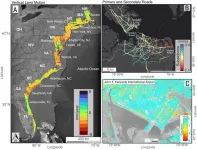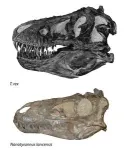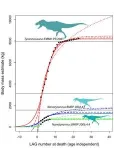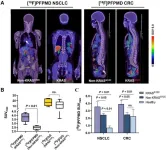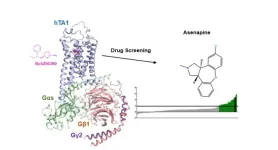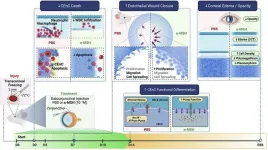(Press-News.org) Major cities on the U.S. Atlantic coast are sinking, in some cases as much as 5 millimeters per year – a decline at the ocean’s edge that well outpaces global sea level rise, confirms new research from Virginia Tech and the U.S. Geological Survey.
Particularly hard hit population centers such as New York City and Long Island, Baltimore, and Virginia Beach and Norfolk are seeing areas of rapid “subsidence,” or sinking land, alongside more slowly sinking or relatively stable ground, increasing the risk to roadways, runways, building foundations, rail lines, and pipelines, according to a study published today in the Proceedings of the National Academies of Sciences.
“Continuous unmitigated subsidence on the U.S. East Coast should cause concern,” said lead author Leonard Ohenhen, a graduate student working with Associate Professor Manoochehr Shirzaei at Virginia Tech’s Earth Observation and Innovation Lab. “This is particularly in areas with a high population and property density and a historical complacency toward infrastructure maintenance.”
Shirzaei and his research team pulled together a vast collection of data points measured by space-based radar satellites and used this highly accurate information to build digital terrain maps that show exactly where sinking landscapes present risks to the health of vital infrastructure. Using the publicly available satellite imagery, Shirzaei and Ohenhen measured millions of occurrences of land subsidence spanning multiple years. They then created some of the world's first high resolution depictions of the land subsidence.
These groundbreaking new maps show that a large area of the East Coast is sinking at least 2 mm per year, with several areas along the mid-Atlantic coast of up to 3,700 square kilometers, or more than 1,400 square miles, sinking more than 5 mm per year, more than the current 4 mm per year global rate of sea level rise.
“We measured subsidence rates of 2 mm per year affecting more than 2 million people and 800,000 properties on the East Coast,” Shirzaei said. “We know to some extent that the land is sinking. Through this study, we highlight that sinking of the land is not an intangible threat. It affects you and I and everyone, it may be gradual, but the impacts are real.”
In several cities along the East Coast, multiple critical infrastructures such as roads, railways, airports, and levees are affected by differing subsidence rates.
“Here, the problem is not just that the land is sinking. The problem is that the hotspots of sinking land intersect directly with population and infrastructure hubs,” said Ohenhen. “For example, significant areas of critical infrastructure in New York, including JFK and LaGuardia airports and its runways, along with the railway systems, are affected by subsidence rates exceeding 2 mm per year. The effects of these right now and into the future are potential damage to infrastructure and increased flood risks."
The new findings appear in the open access journal PNAS Nexus. In the work “Slowly but surely: Exposure of communities and infrastructure to subsidence on the US east coast,” Virginia Tech and U.S. Geological Survey (USGS) scientists measured how much the land along the East Coast has sunk and which areas, populations, and critical infrastructure within 100 km of the coast are at risk of land subsidence. Subsidence can undermine building foundations; damage roads, gas, and water lines; cause building collapse; and exacerbate coastal flooding – especially when paired with sea level rise caused by climate change.
“This information is needed. No one else is providing it,” said Patrick Barnard, a research geologist with the USGS and co-author of the study. “Shirzaei and his Virginia Tech team stepped into that niche with his technical expertise and is providing something extremely valuable.”
END
Study: From NYC to DC and beyond, cities on the East Coast are sinking
2024-01-02
ELSE PRESS RELEASES FROM THIS DATE:
New PET tracer noninvasively identifies cancer gene mutation, allows for more precise diagnosis and therapy
2024-01-02
Reston, VA—A novel PET imaging tracer has been proven to safely and effectively detect a common cancer gene mutation that is an important molecular marker for tumor-targeted therapy. By identifying this mutation early, physicians can tailor treatment plans for patients to achieve the best results. This research was published in the December issue of The Journal of Nuclear Medicine.
Kirsten rat sarcoma (KRAS) is a commonly mutated oncogene that is present in approximately 20-70 percent of cancer cases. Patients with KRAS mutations usually respond poorly to standard therapies. As such, the National Comprehensive ...
Evolution might stop humans from solving climate change, says new study
2024-01-02
Central features of human evolution may stop our species from resolving global environmental problems like climate change, says a new study led by the University of Maine.
Humans have come to dominate the planet with tools and systems to exploit natural resources that were refined over thousands of years through the process of cultural adaptation to the environment. University of Maine evolutionary biologist Tim Waring wanted to know how this process of cultural adaptation to the environment might influence the goal of solving global environmental problems. ...
January issues of APA journals cover antidepressant outcomes, disparities in school-based support, civil commitment hearings, and more
2024-01-02
WASHINGTON, D.C., Jan 2, 2024 — The latest issues of three American Psychiatric Association journals, The American Journal of Psychiatry, Psychiatric Services and The American Journal of Psychotherapy are now available online.
The January issue of The American Journal of Psychiatry features studies focusing on improving clinical outcomes and informing new interventions. Highlights include:
Predicting Acute Changes in Suicidal Ideation and Planning: A Longitudinal Study of Symptom Mediators and the Role of the Menstrual ...
Memory, brain function, and behavior: exploring the intricate connection through fear memories
2024-01-02
In a world grappling with the complexities of mental health conditions like anxiety, depression, and PTSD, new research from Boston University neuroscientist Dr. Steve Ramirez and collaborators offers a unique perspective. The study, recently published in the Journal of Neuroscience, delves into the intricate relationship between fear memories, brain function, and behavioral responses. Dr. Ramirez, along with his co-authors Kaitlyn Dorst, Ryan Senne, Anh Diep, Antje de Boer, Rebecca Suthard, Heloise ...
Demystifying a key receptor in substance use and neuropsychiatric disorders
2024-01-02
New York, NY (January 2, 2024)—Researchers at the Icahn School of Medicine at Mount Sinai have uncovered insights into the potential mechanism of action of the antipsychotic medication asenapine, a possible therapeutic target for substance use and neuropsychiatric disorders. This discovery may pave the way for the development of improved medications targeting the same pathway.
Their findings, detailed in the January 2 online issue of Nature Communications https://doi.org/10.1038/s41467-023-44601-4, show that a brain protein known as the TAAR1 receptor, a drug target known to regulate dopamine signaling in key reward pathways in the brain, differs ...
Elusive cytonemes guide neural development, provide signaling ‘express route’
2024-01-02
St. Jude Children’s Research Hospital scientists found that cytonemes (thin, long, hair-like projections on cells) are important during neural development. Cytonemes connect cells communicating across vast distances but are difficult to capture with microscopy in developing vertebrate tissues. The researchers are the first to find a way to visualize how cytonemes transport signaling molecules during mammalian nervous system development. The findings were published in Cell.
“We showed cytonemes are a direct express route for signal transport,” said corresponding author ...
Pioneering study indicates a potential treatment for corneal endothelial disease, reducing the need for corneal transplants
2024-01-02
Philadelphia, January 2, 2024 – Findings from a pioneering study in The American Journal of Pathology, published by Elsevier, reveal that administration of the neuropeptide α-melanocyte–stimulating hormone (α-MSH) promotes corneal healing and restores normal eye function to an otherwise degenerating and diseased cornea by providing protection against cell death and promoting cell regeneration.
Due to a lack of currently available medical therapy, patients suffering from corneal endothelial disease, ...
Diversity of bioluminescent beetles in Brazilian savanna has declined sharply in 30 years
2024-01-02
At night in the Cerrado, Brazil’s savanna and second-largest biome, larvae of the click beetle Pyrearinus termitilluminans, which live in termite mounds, display green lanterns to capture prey attracted by the bright light.
In more than 30 years of expeditions with his students to Emas National Park and farms around the conservation unit in Goiás state to collect specimens, the phenomenon has never been so rare, said Vadim Viviani, a professor at the Federal University of São Carlos’s Science and Technology for Sustainability Center (CCTS-UFSCar) in Sorocaba, São Paulo state.
“In the 1990s, we ...
Binghamton University professor and Nobel Laureate Stanley Whittingham wins 2023 VinFuture Grand Prize
2024-01-02
Binghamton University, State University of New York Distinguished Professor and Nobel Laureate M. Stanley Whittingham has been chosen as the joint winner of the $3 million 2023 VinFuture Grand Prize in recognition of his contributions to the invention of lithium-ion batteries. The prize recognized how the combination of solar energy and lithium battery storage is overcoming climate change and was recently presented by the Prime Minister of Vietnam.
“I am truly honored to be chosen for this prestigious honor,” said Whittingham. “VinFuture’s efforts to recognize green and sustainable energy is a noble cause, and ...
Deciphering molecular mysteries: new insights into metabolites that control aging and disease
2024-01-02
ITHACA, NY: In a significant advancement in the field of biochemistry, scientists at the Boyce Thompson Institute (BTI) and Cornell University have uncovered new insights into a family of metabolites, acylspermidines, that could change how we understand aging and fight diseases.
The study, recently published in Nature Chemical Biology, presents an unexpected connection between spermidine, a long-known compound present in all living cells, and sirtuins, an enzyme family that regulates many life-essential functions.
Sirtuins ...
